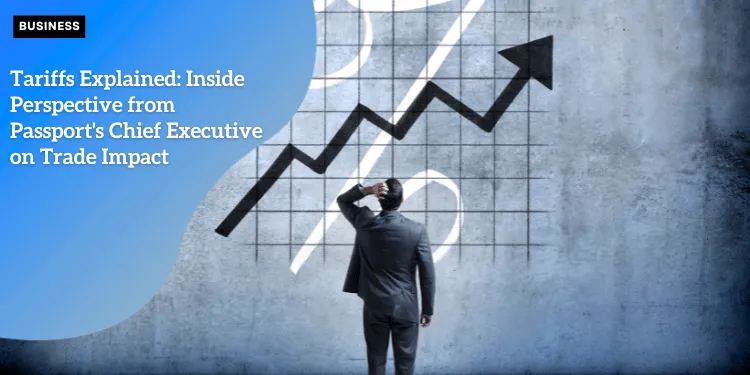Tariffs Explained: Inside Perspective from Passport’s Chief Executive on Trade Impact

Anúncios
Overview of the New 10% Tariff on Chinese Imports
President Trump’s recent implementation of a 10% tariff on all Chinese imports adds to the already significant 39% tariff set by the Biden administration.
This brings the combined tariff burden on Chinese imports to a substantial 49%, creating a challenging landscape for businesses relying on Chinese-made goods.
With these heightened tariffs, companies are forced to reassess their production strategies and supply chains, weighing the economic viability of continuing to manufacture in China against potential alternatives.
 Tariffs Explained
Tariffs Explained
Status Update on Proposed Tariffs for Canada and Mexico
The initial announcement of a 25% tariff on Canadian and Mexican goods was met with concern and confusion, only to be quickly retracted by the administration.
Anúncios
As it stands, there have been no new tariffs imposed on Canadian or Mexican imports.
However, the rapid reversal of this decision indicates an ongoing fluidity in trade policy, which could change at any moment.
Potential Implementation of Reciprocal Tariffs and Their Implications
A particularly intriguing aspect of Trump’s trade policy is the idea of reciprocal tariffs.
Anúncios
This notion suggests that if a foreign country imposes a tariff on U.S. goods, the U.S. would respond with a similar tariff on that country’s goods.
For example, if country “A” places a 50% tariff on U.S. products, the U.S. would impose a 50% tariff on imports from country “A”.
This tit-for-tat approach could lead to escalating trade tensions and increased costs for both importers and consumers.
The implications are far-reaching, affecting market prices, business operations, and international trade dynamics.
While these tariff discussions unfold, it is crucial for businesses to stay informed and prepared to adapt to these evolving trade policies.
Understanding the current status and potential changes can help businesses make strategic decisions that mitigate risks and capitalize on new opportunities.
De Minimis Rules and Their Impact on E-commerce
Current $800 De Minimis Threshold
The U.S. de minimis threshold currently stands at $800, meaning shipments of goods valued under that amount are exempt from tariffs.
This rule provides significant relief to e-commerce sellers, enabling seamless cross-border trade without the burden of added costs.
Essentially, regardless of high tariff rates, if an item’s value falls below the $800 threshold, the tariff is waived, simplifying the import process and minimizing expenses for both sellers and consumers.
Potential Changes to De Minimis Rules for Chinese Goods
However, there have been discussions about altering these de minimis rules, particularly concerning Chinese imports.
According to recent insights, the administration had considered removing the de minimis exemption but later reversed this decision.
Yet, there are persistent rumors that President Trump may remove it again, specifically targeting goods manufactured in China.
Such a change would represent a considerable regulatory shift, requiring additional oversight and potentially costing more to enforce than it would generate in revenue.
Implications for E-commerce and Cross-border Trade
Any amendments to the de minimis rules will profoundly affect the e-commerce landscape.
- 🛒For E-commerce Sellers:
- E-commerce merchants who rely on Chinese manufacturing will face increased costs and additional administrative hurdles.
- The necessity to monitor and enforce these regulatory changes could significantly slow down the import process.
- Small and medium-sized businesses, which might not have the infrastructure to absorb these costs efficiently, would be most impacted.
- 🌐For Cross-border Trade:
- Removing the exemption could deter small-scale cross-border transactions, as businesses adjust to the new cost structures.
- Retail prices might increase, affecting consumer demand and altering global supply chains.
E-commerce sellers, particularly those sourcing from China, should start preparing for potential changes by reevaluating their supply chains and developing contingency plans.
This strategic shift might involve finding alternative suppliers or restructuring their business models to mitigate the impact of these regulatory changes.
Navigating these shifts successfully requires staying informed and adaptable, ensuring compliance with new rules while exploring innovative solutions to maintain competitiveness and efficiency.
Understanding Trump’s Tariff Rationale
National Security and Border Integrity Concerns
President Trump’s tariff policies are largely driven by concerns surrounding national security and border integrity.
One major aspect is the worry over the influx of illicit goods, including fentanyl and other contraband substances.
Implementing tariffs is seen as a method to exert greater control over imports and enhance scrutiny at borders.
Further, the need to maintain a steady supply of critical goods, such as medical supplies highlighted during the COVID-19 pandemic, underscores the national security rationale.
The objective is to reduce dependence on other countries for essential products, ensuring the U.S. can manage its own needs independently during crises.
Addressing Trade Deficits and Perceived Unfair Trade Practices
Another key driver behind Trump’s tariffs is the goal to address significant trade deficits and counter what he perceives as unfair trade practices by other nations.
The U.S. has substantial trade deficits with multiple countries, including China, which means the country imports more goods than it exports, leading to an economic imbalance.
Trump’s tariffs aim to level the playing field by imposing costs on imported goods, thereby encouraging domestic production and diminishing the flow of cheaper foreign products.
There is a belief that this will help revive manufacturing within the U.S., create jobs, and reduce the trade deficit.
America-First Position and Its Influence on Trade Policy
The “America First” mantra has been a cornerstone of Trump’s administration, deeply influencing his trade policy.
This approach prioritizes the interests of American workers and businesses over the principles of free trade.
By imposing tariffs, the administration seeks to protect American industries from being undercut by foreign competitors who can offer lower prices due to different economic conditions.
While this method has been debated for potentially leading to trade wars and increased consumer prices, the intention is to foster an environment where U.S. companies can thrive without the pressure of cheaper imports.
This protectionist stance aims to solidify the economic foundation domestically by ensuring that American-made products become more competitive both in local and global markets.
As we delve deeper, understanding the broader implications of these tariffs on e-commerce merchants and navigating the challenges of global trade becomes essential.
The journey through these complex dynamics highlights the significance of strategic adaptation and compliance in an evolving trade landscape.
Impact on E-commerce Merchants
Implications for Businesses Manufacturing in China
If you’re an e-commerce merchant manufacturing goods in China, you’re likely feeling the pinch from the newly added 10% tariff on Chinese imports, raising the total to a hefty 49% when combined with the previous Biden administration tariff.
This sudden cost increase necessitates re-evaluating supply chains and the bill of materials. Is the extra 10% impactful enough to consider alternative suppliers or manufacturing locations? The answer varies but prompts a necessary review of your business strategy.
Challenges for Direct-to-Consumer Sellers Shipping from China
For direct-to-consumer sellers shipping products from China, the challenges are even greater.
With the current de minimis threshold of $800 likely to be revised, and possibly removed for Chinese goods, the cost structure could become significantly more burdensome.
Sellers may soon face the prospect of paying duties on the retail sales price or trying to navigate the murky waters of paying the duty on the cost of goods sold—both bring financial and logistical uncertainties.
It’s crucial for these sellers to develop contingency plans and prepare for potential cost increases and increased administrative workload.
Continuing operations as usual until the bitter end while crafting a plan B is advisable, ensuring they’re ready for any sudden changes.
Opportunities for U.S.-Based Manufacturers
Interestingly, while these tariffs pose challenges for those reliant on Chinese manufacturing, they offer potential advantages for U.S.-based manufacturers.
Merchants producing goods domestically may find themselves in a more favorable position, cheering on the administration to push foreign countries to lower their tariffs, thereby expanding their market reach.
This scenario could create a competitive edge for U.S.-based products, especially if other countries reciprocate by lowering their tariffs, making U.S. goods more attractive globally.
Given these complexities, staying compliant, informed, and adaptive is key to thriving in this evolving trade environment.
This concludes the insights on how tariffs impact e-commerce merchants.
Transitioning forward, staying globally competitive requires strategic navigation amidst these regulatory changes.
Navigating Global Trade Challenges
The Role of International Logistics Providers
Navigating global trade entails a complex interplay of logistics, regulations, and market dynamics.
International logistics providers such as Passport play a pivotal role in this ecosystem.
They enable businesses to operate seamlessly across borders regardless of size. These providers manage crucial tasks:
- 💼 Collecting accurate duties and taxes
- 💵 Displaying local currencies
- 📜 Handling regulatory and fiscal compliance
Beyond these foundational services, companies like Passport are increasingly taking on end-to-end operational roles.
For instance, by acquiring Brand Access, Passport can now assist businesses in setting up local operations in-country, which includes logistics, warehousing, and acting as the importer of record.
This comprehensive support helps streamline the international expansion efforts for e-commerce merchants and ensures a higher conversion rate by optimizing the front-end consumer experience.
Importance of Compliance and Data Collection
Compliance and data collection are at the heart of international shipping and trade.
Staying compliant with varying international standards while collecting and transmitting the required data can be daunting.
However, it is essential for avoiding penalties and ensuring smooth operations.
In many cases, the compliance requirements imposed by foreign governments are more stringent than those in the U.S.
Passport’s participation in this strict data flow ensures that merchants’ goods meet all regulatory criteria, thereby minimizing disruptions.
Rigorous data collection not only meets compliance standards but also supports national security by monitoring imports, including sensitive items such as medical supplies or prohibited substances.
Strategies for Adapting to Changing Tariff Landscapes
| Strategy | Description |
|---|---|
| 🌍 Diversifying Supply Chains | Explore alternative manufacturing sources and regions to mitigate the impact of the 10% tariff on Chinese imports, in addition to the existing 39% tariff. |
| 🚚 Leveraging Logistics Expertise | Work with cross-border logistics providers to navigate shipping, compliance, and cost management challenges, ensuring smoother international trade. |
| 💵 Maximizing De Minimis Thresholds | Take full advantage of the $800 de minimis threshold for tariff exemptions to reduce costs and mitigate the financial burden of increased tariffs. |
| 🏢 Strategic Placement of Operations | Establish local offices or warehouses in key markets to reduce import duties and delivery times while ensuring greater proximity to end consumers. |
Adapting to an evolving tariff landscape demands a proactive approach and the ability to pivot quickly.
By integrating robust logistics support, maintaining compliance, and strategically managing operations, e-commerce merchants can navigate these global trade challenges effectively.
As businesses continue to adjust to these new realities, staying informed and agile will be key to thriving in this dynamic environment.
